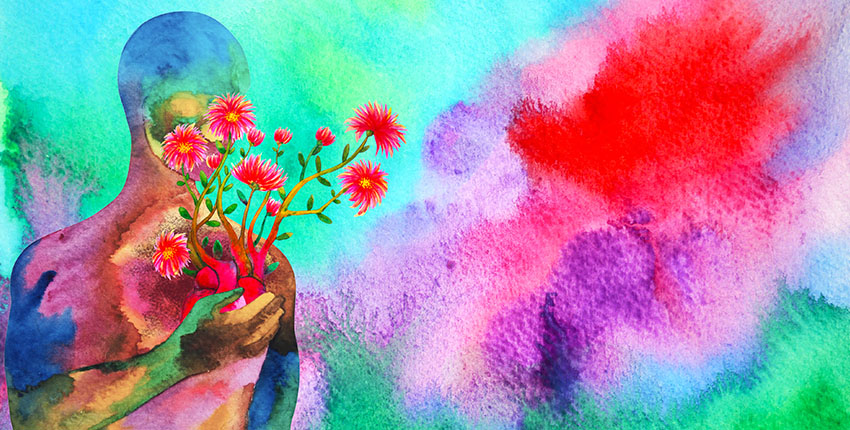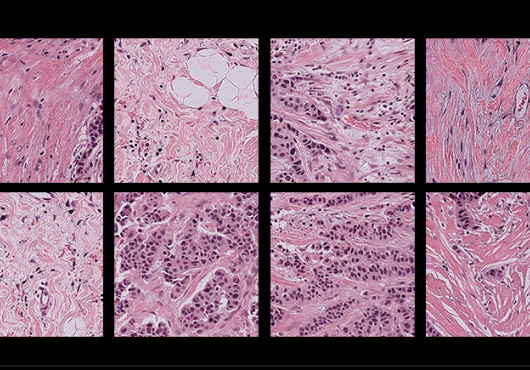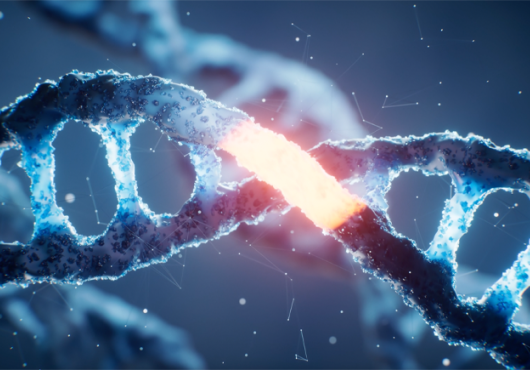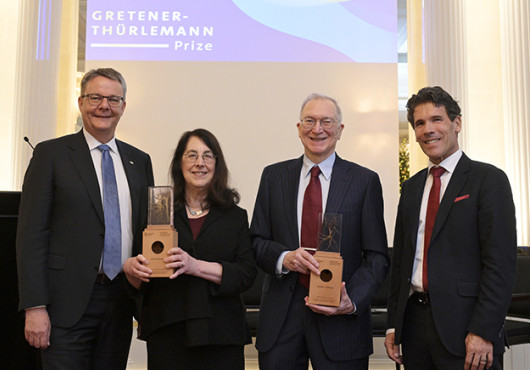
Love has been the source of ceaseless fascination since antiquity. Artists have tried to capture its beauty and darkness in books, paintings, and songs. Behavioral scientists have explored love as a social ritual, psychologists have studied its pathological manifestations, and evolutionary biologists have sought to define it as a drive linked to the very survival of our species.
What are some of the most tantalizing insights that science has gleaned about a behavior that so intensely captivates our collective imagination but continues to defy understanding?
For starters, both romantic and nonromantic love appear to be essential to our overall well-being and, indeed, survival, according to Richard S. Schwartz, HMS associate professor of psychiatry, part-time, at McLean Hospital, and Jacqueline Olds, HMS associate professor of psychiatry, part-time, at Massachusetts General Hospital. Schwartz and Olds, who have been married to each other for nearly five decades, study how love evolves and how it can fall apart.
The ubiquity of love across societies and its endurance across millennia is likely rooted in something basic and primal to human nature, Schwartz and Olds say. While it’s unclear whether being head over heels itself confers any direct evolutionary advantages, research suggests that romantic love may be a tool to achieve pairing and commitment that ensures optimal conditions for rearing children.
“Given the long period of helplessness of human offspring, some kind of sustained pair bonding is clearly essential, but there is no reason to think it must be romantic,” Schwartz said. “But it may be essential to what we think of as human nature. Evidence of romantic love has been found in essentially every culture.”
The brain on love: a chemical cascade with ups and downs
The importance of finding a mate is evident in the dramatic physiologic reaction triggered by falling in love, akin to a stress response that mobilizes our physical energy and strength.
“The effort to win the heart of our beloved is a high-stakes and dangerous game,” Schwartz said.
Indeed, studies have shown that falling in love sets off a neurochemical cascade that includes the release of stress hormones.
“Falling in love is turbulent and stressful, with levels of cortisol rising,” Schwartz said. “There is also increased activity in the dopaminergic reward centers, and research shows increased levels of testosterone in both men and women.”
Interestingly, Schwartz notes, research also shows that people experience decreases in serotonin levels, similar to what is seen in obsessive states and depression.
With time, however, these neurochemical aberrations normalize.
“Cortisol and serotonin activity return to baseline,” Schwartz said. “Testosterone levels decrease, but happily dopaminergic activity stays high and the ‘bonding’ neurotransmitters oxytocin and vasopressin increase.”
This return of cortisol and adrenaline to normal levels is also essential for survival.
“Research shows that the human body can stand and even flourish with stress up to eight weeks, but after that the stress hormones can wear down the body’s most important organs,” Olds said. “When we can moderate stress by being surer that our loved person will stay in our life, our stress hormones thankfully decrease to more normal levels.”
Olds and Schwartz say that two of the most pivotal discoveries about love and attachment to emerge in the past 50 or so years have to do with the experience of lost love and with its endurance. One of them is the finding that the emotional pain in losing someone you love is registered in the same areas of the brain as physical pain. The other is the demonstration that the brains of people who report being madly in love with their longtime partners show activity in the dopaminergic reward centers, similar to levels seen in the first months of love. At the same time, however, their brains also show more calming activity in areas rich in opioid and oxytocin receptors.
“The mysteries of love are many,” said Olds. “For example, how much of it has to do with cultivated habits of curiosity, kindness, and connection and how much is that magical concept we sometimes call ‘good chemistry.’”
Reassuringly, Schwartz and Olds say, attachment and love need not be of the romantic kind to exercise their beneficial effects on the brain. Throughout history, humans survived and thrived because of membership and belonging to groups, and these benefits remain even today, extending to mental and physical health.
“We do know that nonromantic love is very salutary,” said Olds. “All of our data on loneliness and the benefits of having a social network, as well as a much smaller network of close friends, supports the belief that there are incredible health benefits of having friends, and even connections with people less close.”
The dark side of love and the agony of loss
While the presence of love yields biochemical changes with decidedly beneficial effects, its crushing loss can likewise have its own potent repercussions. One striking, if extreme, example of the physiologic dangers of intense emotional pain is broken heart syndrome.
The disorder, described in a defining 2005 paper by Johns Hopkins cardiologist Ilan Wittstein, is also known as stress cardiomyopathy or takotsubo syndrome, so called because of a temporary swelling of the heart’s left ventricle that makes the organ resemble a pot used in Japan to catch octopuses. While the condition can be triggered by different emotional stressors, many of the patients described in the study had developed symptoms after the loss of a loved one.
Patients experience symptoms suggestive of heart attacks or heart failure. Indeed, individuals in the 2005 study had changes in EKG patterns suggestive of heart attacks and proteins in the blood indicative of heart-muscle injury. But their hearts showed no signs of coronary heart disease — the inflamed and clogged arteries that are the culprits behind most heart attacks. The mechanism underlying this temporary heart dysfunction seen in broken heart syndrome is believed to stem from the sudden triggering of stress responses, including sympathetic system stimulation, and the release of stress hormones that overwhelm the heart muscle, temporarily weakening it. In nearly all cases, the dysfunction is reversible, and heart function is restored within weeks of initial presentation.
Since the publication of Wittstein’s paper 20 years ago, scientists have built on these initial observations and probed further the connections between the brain and the heart. One of them is Harvard Medical School researcher Ahmed Tawakol, HMS associate professor of medicine and cardiologist at Massachusetts General Hospital.
For a 2021 study, Tawakol and colleagues examined a large database of PET and CT scans of patients with and without broken heart syndrome. The team evaluated brain images obtained before the individuals developed broken heart syndrome and measured activity in the amygdala, a part of the brain considered critical to the body’s stress response. They found that individuals who subsequently developed broken heart syndrome tended to have higher amygdalar activity, suggesting that a broken heart may be rooted in neurochemical changes that start in the brain.
They also found that among those who later developed broken heart syndrome, those with the highest amygdalar activity developed broken heart syndrome sooner than those with lower amygdalar activity. “It seems that the more easily triggered those regions are, the higher the risk that exposure to a stressor would elicit broken heart syndrome,” Tawakol said.
Studies continue to support the important role of neural regions related to stress response.
Additionally, says Tawakol, more is being learned about some of the downstream manifestations of this brain-heart link, including abnormalities in the sympathetic nervous system, inflammatory responses, and control of blood flow through the coronary arteries.
“We hope that as we gain more insights into these mechanisms, we can better target those processes to reduce the risk of broken heart syndrome,” he said.
What the love lives of fruit flies teach us about human connection
Some scientists seeking to elucidate human attachment and relationships, romantic and otherwise, are looking for answers from insects.
Two of those researchers are Dragana Rogulja, associate professor of neurobiology in the Blavatnik Institute at Harvard Medical School, and Michael Crickmore, associate professor of neurology at Harvard Medical School and the F.M. Kirby Neurobiology Center at Boston Children’s Hospital. They have been together for 23 years and married for 18 and study a range of biologic phenomena, including sleep, gene activation, and circadian rhythms in fruit flies. These tiny insects, it turns out, can also explain elements of romantic attraction.
Rogulja and Crickmore work with fruit flies as a model organism to study courtship rituals, but their ultimate quest is to help unravel the neurobiology behind human motivation and develop strategies for the treatment of human disorders where motivation goes awry, such as in addiction and depression. In that sense, their study of the love lives of fruit flies is a way to illuminate the brain more broadly. The researchers’ explorations take place in parts of the insect brain that house motivation circuitry — the interconnected sets of neurons that fruit flies use to choose whether to do things like mating, eating, and sleeping.
In a 2018 study, the scientists found that courtship and mating behaviors are driven partly by chance. The role of chance appears to be a critical differentiator between motivation brain circuits and the circuits responsible for processing sensory or motor signals. And so does the decision whether to pursue a love interest or another goal.
Do we know whether and how the neural mechanisms of attraction observed in fruit flies compare with those in humans?
Clues have started to emerge. In a recent preprint, the team showed that dopamine released during one encounter leads to desensitization to the same levels of dopamine released on a subsequent, similar encounter.
“That result explains a good deal about the human condition,” Crickmore said.
Love, connection, and social relationships as wellsprings of well-being
Despite the lingering mysteries around attraction, love, and their demise, there seems to be little or no disagreement about how critically important relationships are to our very existence, says Robert Waldinger, HMS professor of psychiatry, part-time, and director of the Harvard Study of Adult Development at Massachusetts General Hospital, which has been running for more than 80 years.
Waldinger said his research and other studies in the field have found convincing evidence that relationships and how happy we are in them profoundly influence our health. Research has indicated the level of satisfaction with relationships in midlife is a good predictor of healthy aging.
“Science shows us that being securely attached to at least one other person is a bedrock of well-being,” said Waldinger.
Research by Waldinger and others has also focused on the danger posed by social isolation and the loneliness that can arise with an absence of human-to-human connectedness and interactions, whether friendships or romantic relationships, particularly among young individuals and older people.
A growing body of evidence has suggested that loneliness drives stroke risk, amplifies the likelihood of suffering a heart attack, and contributes to the overall risk of death. It may also precipitate the development or worsen conditions including type 2 diabetes, dementia, depression, and anxiety, according to the Centers for Disease Control and Prevention. While the precise mechanisms remain to be elucidated, researchers believe that both the lack of social support and the sheer physiologic stress of loneliness are at play. For example, research suggests that the chronic activation of the hypothalamic-pituitary-adrenal axis — a communication pathway across three glands that play a role in the body’s stress response — may unleash a downstream signaling cascade that fuels inflammation, which could, in turn, interfere with a number of physiologic functions.
And while the beneficial physical and emotional effects of love are evident, Waldinger said, love itself will continue to defy efforts to deconstruct it and will remain empirically elusive. And that is fine by him.
“Looking at human connection through hormonal, neurochemical, and behavioral lenses will undoubtedly continue to shed light on our most intimate relationships, but thankfully, love is too rich, complex, and varied to yield all its secrets to empirical investigation.”



